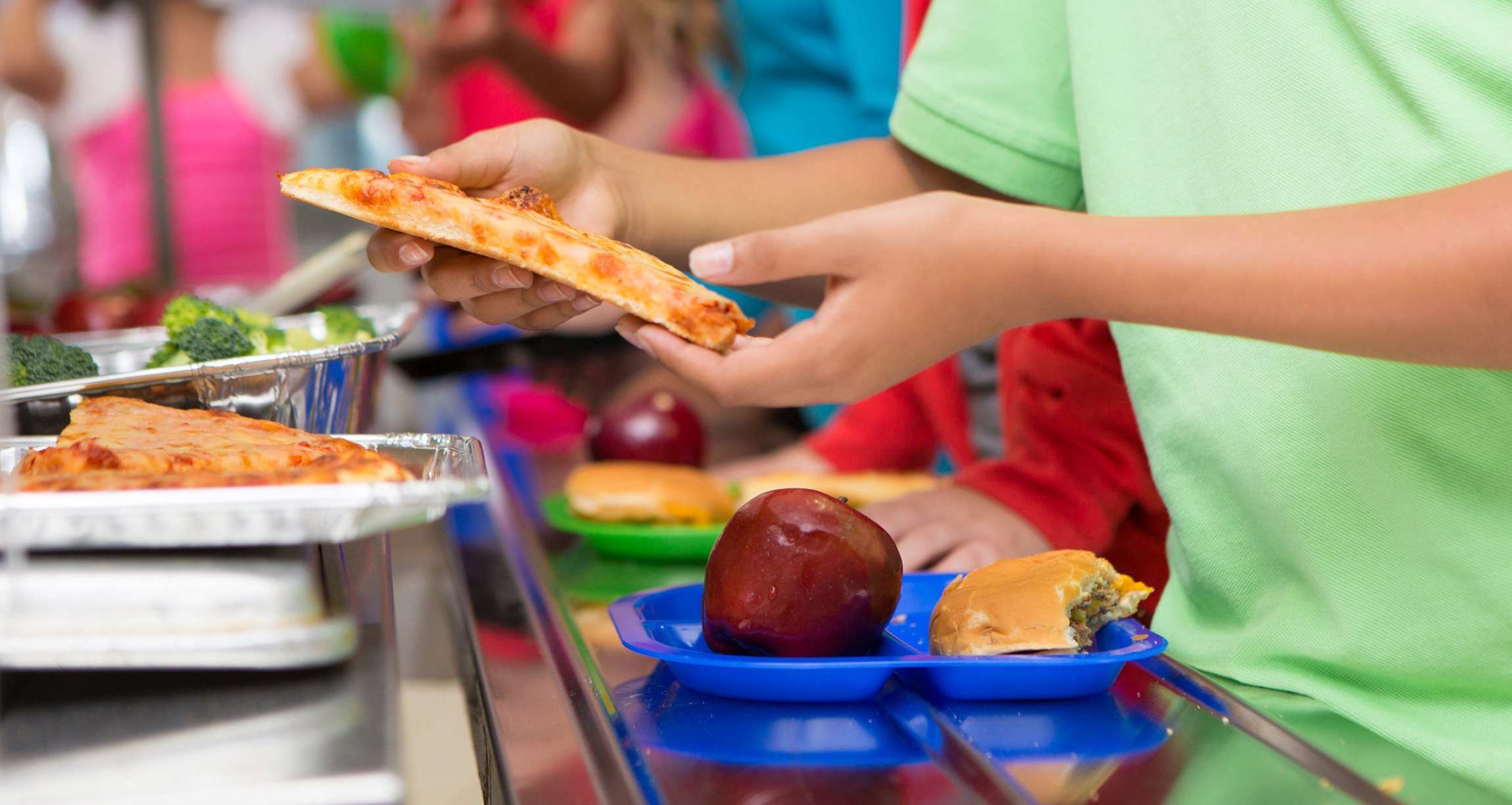Debates about school lunch have been going on for more than a century. Learn why school lunches in America have a terrible reputation and how you can help make a difference.
School lunch matters — for better learning and academic performance, for improved behavior and performance at school, for the overall health of kids, and much more.
In fact, school meals can have tremendous impacts on the next generation, the future of a country, and maybe even the future of our world.
The State of School Lunches In America
In the U.S., school lunches have a terrible reputation.
A 2009 investigation by USA Today found that meat served in U.S. schools wouldn’t meet the quality or safety standards of fast-food restaurants. And according to the book Lunch Lessons, almost half the vegetables eaten by most children aged 2 to 19 in the U.S. were French fries.
Although America’s school lunches have improved since Congress strengthened the standards for the national school lunch program in 2010, they have a long way to go.
Most menus now include more whole grains and more fruit and vegetable options and less salt. But they also offer an abundance of factory-farmed animal products and heavily processed foods, like corn dogs, tater tots, and cheese pizza.
But School Lunches Can Improve
Programs exist to help improve food at schools, and some schools are taking bold, inspiring steps. Parents, educators, students, and everyone can take action to help students have access to healthier foods.
As Ocean Robbins says in his upcoming book 31-Day Food Revolution, “As long as tens of millions of families depend on school meals for a fundamental part of daily nutrition, we all have a stake in making them healthier.”
As long as tens of millions of families depend on school meals for a fundamental part of daily nutrition, we all have a stake in making them healthier.
Why Are School Lunches in America Unhealthy?

Many countries around the world serve school lunch for students. In America, midday meals have been a fixture in education for more than 70 years.
A variety of factors contribute to the school lunches in the U.S. today. Here are some of them:
Funding
The National School Lunch Program provides low-cost or free school lunches to 31 million students at more than 100,000 public and private schools per day. Meals must meet nutritional standards based on the Dietary Guidelines for Americans.
Participating schools receive approximately $1.30 to spend for each child. This amount must cover the food, as well as any labor, equipment, electricity, and other costs. School food programs also depend on income from students who often pay for the food they eat.
Tight budgets make serving healthier foods challenging.
The USDA Foods Program
The United States Department of Agriculture purchases hundreds of millions of dollars worth of agricultural products and gives them to schools for free. (The government does this to stabilize food prices and to ensure demand for the country’s agricultural goods.)
Free food may sound good, especially when funding is so limited. But in 2015, 64% of the program’s spending went to meat, dairy, and egg products. Virtually all these products came from factory farms.
The School Milk Program
Why does almost every school lunch include milk? Because milk in schools has been federally subsidized since 1940.
In the 2013-14 school year, more than $20 million taxpayer dollars were spent directly by the USDA on dairy product subsidies that went into child nutrition programs, including school lunch.
Even though most schools now ban sodas and other sugary beverages, chocolate milk still gets a pass. A single serving of chocolate milk contains between four and six teaspoons of sugar.
And there are many reasons why all this milk might not be the healthiest option for our kids.
Unhealthy School Vendors
Some schools have given contracts to food management companies to manage the food offered to students. In these cases, the companies have the purchasing power — not the schools.
The contracting most often goes to one of three main corporations: Aramark, Compass Group, and Sodexo. These companies are in business to make money, and it seems that children’s health isn’t always their top priority.
Why the Quality of School Lunches Matters for Students

Children consume up to 50% of their daily calories at school. And for low-income children, lunch may be the only real meal of the day.
Here are seven reasons to feed kids healthy, well-balanced meals:
1) Better Learning and Memory
As studies show, children who are hungry or undernourished are unable to focus and have a hard time learning.
According to a 2008 study published in Nature Reviews Neuroscience, diets with high levels of saturated fats may impair learning and memory. Many foods commonly served during school lunch, such as French fries, cheeseburgers, and chicken nuggets, are loaded with saturated fat.
When kids get adequate nutrition, they are sick fewer days and don’t need to miss school, which can lead to improved performance.
A 2011 study published in the Journal of Health Economics showed that when Greenwich switched from low-budget processed meals towards healthier options, educational outcomes improved and authorized absences fell by 14%.
2) Improved Concentration
Deficiencies in vitamins and minerals are shown to diminish cognitive abilities and mental concentration. Many school lunches are low in the fruits, vegetables, and whole foods that provide an abundance of vitamins and minerals.
3) Better Overall Health
A 2008 study published in the Journal of School Health found that effective school nutrition programs “have the potential to improve student’s diet quality, academic performance, and, over the long term, their health.”
4) Better Behavior and Fewer Problems
A series of studies in the 1980s removed chemical additives and processed food, and reduced levels of sugar, in the diets of more than 8,000 juvenile delinquents in 12 correctional facilities.
What was the result? Problem behaviors fell 47%.
Similarly, in Virginia, 300 particularly hardened juvenile delinquents were put on a diet with no chemical additives and little sugar for two years. During that time, incidences of theft fell 77%, insubordination dropped 55%, and hyperactivity went down by 65%.
Also, in 2008, a comprehensive analysis from the Harvard School of Public Health concluded that students with access to nutritious meals had lower rates of aggression and disciplinary problems.
5) Better Academic Performance
According to a study conducted at the University of California at Berkeley, students who eat healthier school lunches achieve higher standardized test scores.
And a 2008 study published in the Journal of School Health found an association between higher quality diets and better performance on exams.
6) Reducing Obesity
Obesity rates among children nearly tripled from 1970 to 2000. And according to a 2017 projection published in The New England Journal of Medicine, most 2-year-olds in America today will develop obesity by the time they turn 35. But could school lunches help reduce obesity?
A 2013 study published in JAMA Pediatrics showed that children residing in states with stringent nutritional standards for school meals had lower rates of obesity than those states with more lax regulations.
And a 2018 nationwide study conducted in Japan and published in the Journal of Public Health concluded that “Appropriate nutritional intake through school lunch may be effective to reduce childhood obesity.” (Japan has a relatively low childhood obesity rate and one of the world’s most successful nationwide school lunch programs.)
7) Better Habits for the Future
Researchers say that the eating patterns kids develop early in life typically follow them into adulthood.
A group of Canadian researchers said: “If children are to learn to prefer and select healthy foods, they need early, positive, repeated experiences with those foods.”
Federal Changes to Make American School Lunches Healthier
In 2010, Congress adopted the Healthy, Hunger-Free Kids Act — the first significant change to school meal nutrition in more than 15 years.
If children are to learn to prefer and select healthy foods, they need early, positive, repeated experiences with those foods.
The standards went into effect in 2012, with schools that met the new criteria receiving additional funding. And federal funding for school lunches increased — by about six cents per meal — for the first time in more than three decades.
Schools are now required to:
- Offer fruit daily at breakfast and lunch
- Offer vegetables daily at lunch
- Increase the amount of whole grains
- Require students to select either a fruit or vegetable with each meal
- Reduce the sodium content of meals
- Only offer fat-free or low-fat milk varieties
- Create grade-specific limits on total calories
- Remove trans fats
Researchers who examined 1.7 million meals in an urban Washington State school district found that the overall nutritional quality of meals increased by 29% after the standards took effect.
Problems Faced by School Lunch Programs
But despite these improvements, many nutritional experts still find school lunches to be inadequate. Most meals aren’t prepared from scratch and don’t use fresh fruits and vegetables. Instead, foods are frozen or made elsewhere and then heated before serving. This food preparation creates meals that are far from fresh and, sadly, unappealing.
And the new federal administration is scaling back the updated school meal nutrition requirements, which could lead to less nutritious foods in many schools.
10 Ways You Can Help Improve School Food

Even though it can feel daunting to get involved, simple steps can have meaningful impacts on improving food in schools.
You may want to start by educating yourself about your school’s food-service program by checking the district’s or school’s website.
And here are some ideas for taking action to improve school meals:
Show your support for healthy school lunches in your community.
You can set up a meeting with your local school district’s Food Service Director (or your school superintendent) to find out what changes are already in progress and to see how you can help.
Be an advocate for healthier food in your school district.
The Chef Ann Foundation has a parent advocacy toolkit. Physicians Committee for Responsible Medicine has a healthy school lunch campaign. They offer resources for schools, parents, and schools.
Start a farm-to-school program.
You can find some suggestions from Kids Health here.
Get a school garden in a school.
You can find helpful guides and resources from The Lunch Box here.
Start Meatless Mondays in a school.
Foodservice workers can use this guide from Meatless Monday. Students, parents, and staff can use this ambassador guide from Meatless Monday.
Advocate for more plant-based options.
You can try encouraging a school to offer one plant-based entree per day by sharing recipes and testing them with staff. Amie Hamlin, the executive director of the New York Coalition for Healthy School Food, which offers 13 plant-based, kid-approved recipes, suggests this idea to make an impact
Help increase nutrition education in a school.
You can help implement the Coalition for Healthy School Food’s Wellness Wakeup Call, which provides schools and classrooms with daily, healthy eating tips that can be read in classrooms and over PA systems. This program is free for schools in New York, but out-of-state schools can use it for a small fee.
Advocate for lunchtimes that are long enough for students to get to eat.
You can advocate for lunches that are at least 30 minutes long and for scheduling recess before lunch. Research backs up these changes for getting kids to eat more fruits and veggies. The Peaceful Playgrounds Foundation has resources to help lengthen lunches.
Contact elected officials.
You can support legislation and funding that promote healthier school lunches. Contact your elected officials and let them know why healthy school lunches matter. Call to schedule a meeting with your member of Congress to speak out for federal change, with local school board members, or with a school board superintendent to take action locally. You can sign up for action alerts from the School Nutrition Associate Action Network to stay informed and engaged about school nutrition policy issues.
Students can take action, too.
The School Nutrition Association has 10 tips for students who want to make a difference in the school cafeteria.
What If School Lunches Around the World Encouraged Healthy Eating Behaviors?
Children’s bodies and brains are still developing — and the habits and attitudes they’ll carry with them throughout life are being formed.
Healthy, balanced school lunches could lead to better health and better academic performance for students. They could lead to reduced aggression, hyperactivity, and other problems. And they could help break the cycles that trap low-income children in poor health.
Healthy school lunches could also help reverse childhood obesity trends, which lead to type 2 diabetes and other chronic illness. And they could contribute to a healthier and more productive future for the next generation.
As former President Harry S. Truman said when signing the National School Lunch Act: “No nation is any healthier than its children or more prosperous than its farmers.”
Tell us in the comments:
-
What are your experiences with school lunch?
-
How will you take action?

Featured Image: iStock.com/SDI Productions



